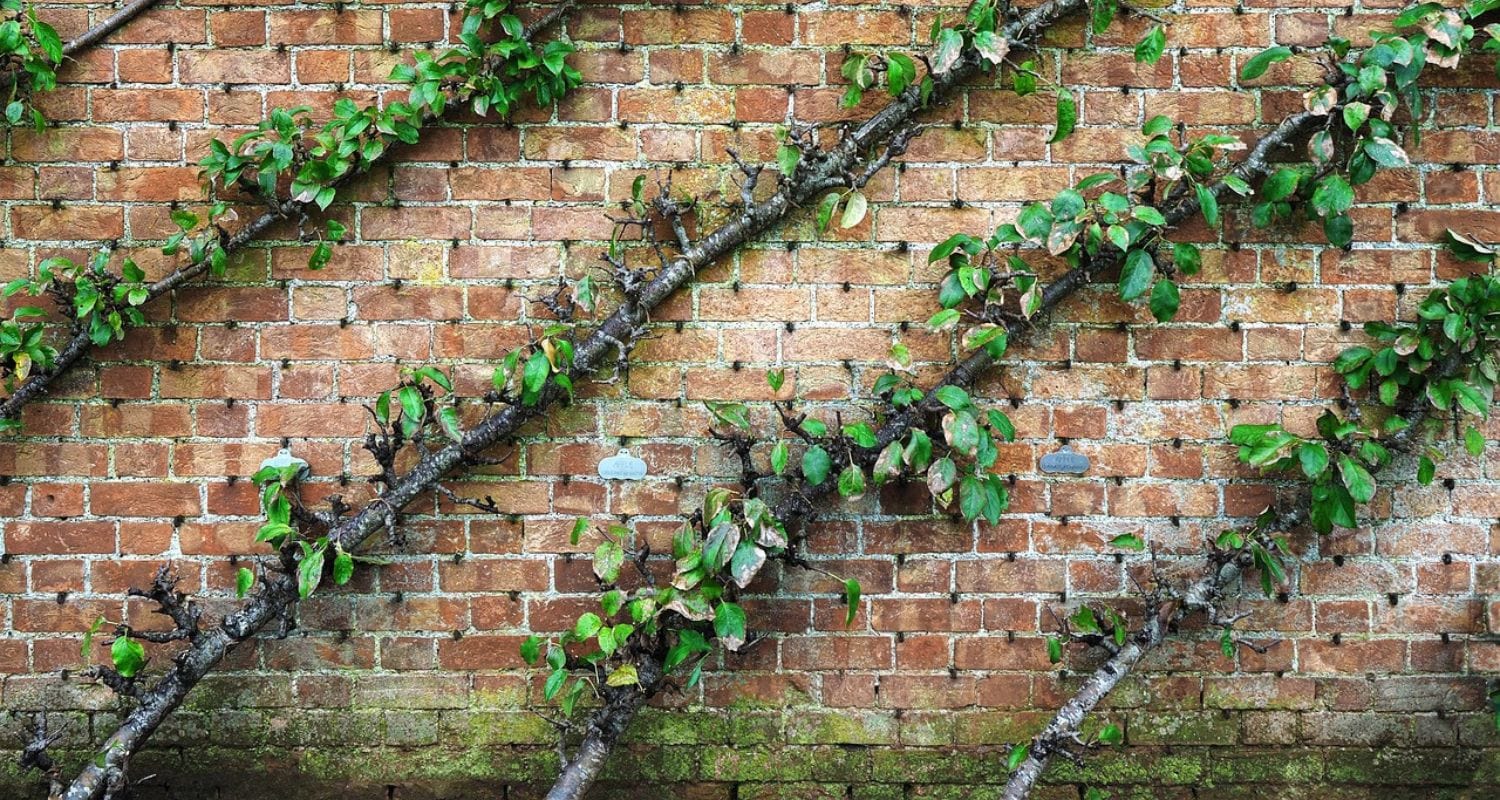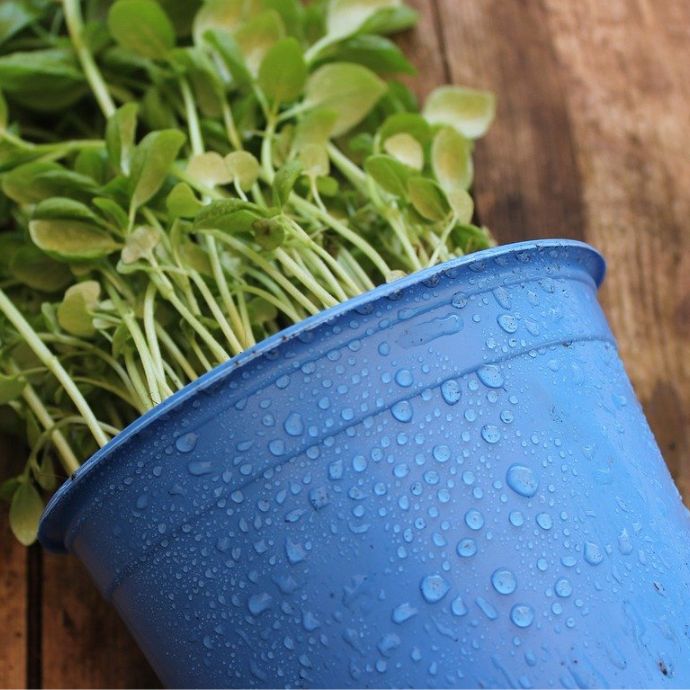Advice & Inspiration
Cordon Apple Trees: A Complete Guide

What are cordon apple trees, we hear you say? Cordon apple trees (AKA columnar apple trees) are cute, space-saving mini trees that have just one main stem with short branches that carry the fruit and flowers.
At around 2m tall and 1m wide or less, compact cordons mean that you can fit two or three trees in the same space that one would usually occupy, while still getting a good amount of fruit. Ingenious.
Apple trees are the best fruit for growing as cordons, whether you decide to train your own or go for a ready trained tree. Here’s all you need to know about growing, training and caring for your cordon apple.
Jump to:
- How are cordon apple trees grown?
- How much fruit do cordons produce?
- Planting cordon apple trees
- Do cordon trees need support?
- Training cordon apple trees
- Caring for cordon apple trees
- Cordon apple trees in pots
- Pruning cordon apple trees
- Ready trained cordon apple trees
- Can you cordon train other trees?
How are cordon apple trees grown?
Cordon apple trees are usually grown on a dwarf or semi-dwarf rootstock like M9 or M26, which means the mature tree will grow to a maximum height of just 2m.
Traditionally, cordons were grown at a 45 degree angle as a space-saving method on fruit farms and in orchards, but these days they’re often grown vertically, which makes them ideal for patio pots.
The young trees are trained into a cordon shape by careful pruning, resulting in a single trunk with short fruit producing spurs. Unlike regular trees, they’re prevented from growing into the conventional bushy or standard form, or branching out sideways.
How much fruit do cordons produce?
As they don’t have long side branches, cordon apple trees won’t produce a crop to compare with a standard or bushy tree.
However, if it’s trained well from the start and pruned carefully to avoid damaging the spurs, a mature cordon can yield up to 10kg of fruit every year - that’s an average of fifty apples - compared with 15kg from a regular tree.
Bear in mind, too, that with cordons, you can fit more trees into the space you have available, so you can end up with just as many apples, but mix and match the varieties.

Credit: quisnovus, Flickr
Planting cordon apple trees
When and where to plant your cordon
The best time to plant your cordon tree is in early spring before the tree has put on too much growth, or in late autumn when the tree is dormant. Planting at these times allows the young tree plenty of time to develop its root system before any extreme temperatures set in, but as long as the ground isn’t too dry, frozen or waterlogged, any time of year is fine. For both angled and freestanding cordons, most parts of the planting process are the same.
You can plant your cordon tree against a wall or fence, in a pot or freestanding in a border. The best position to choose in any case is a sunny, sheltered spot where your tree will get at least six hours (or preferably eight) of sun daily.
If you’re planting more than one, allow 60-90cm between each one, so that each tree can get plenty of air and sunlight.
How to plant your cordon
If your tree is bare root, aim to plant it as soon as possible after it arrives. Before planting, soak the roots in a bucket of water for about an hour. You won’t need to do this with a potted tree, just gently remove it from its nursery pot or ecowrap and tease out the roots if necessary.
Dig a hole as large as the tree’s root ball and 15cm away from any fence or wall. Add a sprinkle of Rootgrow to the planting hole and some compost or manure to enrich the soil.
Position the tree in the centre of the hole, replace the soil and firm it down. Then give your new tree a good watering to settle the roots and a layer of mulch around the base to keep moisture in the soil and reduce weeds.
Do you need to support cordon trees?
Your new cordon tree will benefit from some support as it grows. For one or more cordons on a wall or fence, you’ll need to build a framework of horizontal supporting wires from the bottom to the top of the wall, at around 35cm apart. Allow 60-90cm width of wire for each cordon.
If you’re growing your cordons against a fence, you can fix the wires between posts using eye bolts. If you’re using a wall, it’s a good idea to use vine eyes and a tightener to make sure the structure is strong enough.
For a single, freestanding cordon, simply use a long, sturdy support cane for each tree - a cane of around 2.4m will be sufficient.

Credit: Kirsty, Flickr
How to train a cordon apple tree
If you’re starting from scratch and training your own cordon tree, here’s how:
1. Choose your tree
It all starts with choosing the right tree; you’ll need to make sure it’s a spur bearing variety grown on a dwarfing or semi-dwarfing rootstock. Apple trees can be spur bearers, tip bearers or partial tip bearers, but the kind you want, spur bearing, means that the tree produces fruit on short branched shoots of older wood close to the trunk.
This makes them ideal for training as you can safely prune the ends of the branches without losing fruit. Some spur bearing apple varieties include Bountiful, Braeburn, Cox’s Orange Pippin, Dabinett, Falstaff, Fiesta, Gala, Golden Delicious, James Grieve, Jonagold, Katy, Laxton’s Superb, Red Devil, Red Windsor, Rubinette and Spartan. As you can see, there’s plenty of choice.
Bare root trees tend to be better for training, but a potted tree will also work.
2. Train your tree
To plant cordon trees at an angle on your wall, tie in a long bamboo cane (one for each tree) to your support wires at about 45 degrees.
Make sure that the scion (the part of the wood above the graft line) is above the ground and pointing upwards, to avoid the tree breaking. Plant your trees about 15cm from the wall and 60-90cm apart, tying them in firmly to the bamboo canes.
For freestanding vertical cordons, simply tie in your tree’s main stem firmly to the support cane and reduce the size of any long, thin branches (over 23cm) growing out from it.
Once your tree is planted and supported, here’s how to care for it.
How to care for cordon apple trees
Cordon trees may seem more complicated, but they have the same care requirements as regular apple trees, with the exception of a different pruning technique (see below).
When your tree is newly planted, you’ll need to water it regularly (unless the British weather takes care of it for you) but once it’s established after a year or so, you can reduce this to watering during hot and dry weather only, as the root system will be well-established.
Your apple tree will benefit from a feed once a year in spring - use a general purpose, slow release plant food - and a fresh layer of mulch every autumn.

Cordon apple trees in pots
Lots of people grow cordon trees in pots - they’re ideal for getting fruit from small spaces like balconies, yards and patios. Choose one that’s at least 45cm wide and deep, with drainage holes in the bottom, and put it in the sunniest spot you can find.
Trees grown in pots need more regular watering, as the soil dries out more quickly - putting a layer of mulch on top of the soil can help with this by keeping moisture in the soil and protecting it from drying winds. Your potted tree will appreciate more regular feeding too - as a general rule, increase this to twice or three times during the growing season.
You should also check your tree every two years to see if it needs a bigger pot. If you find the soil is drying out quicker than usual, the roots are poking out through the drainage holes, the tree looks unhappy and/or ridiculous, chances are it’s a repotting job. Choose a pot at least 25% larger than the previous one when you do this, and use fresh compost every time.

Pruning cordon apple trees
Cordons should be pruned in August or early September - this is because as autumn approaches, the tree’s sap levels fall. In spring, the tree uses that sap to grow branches, so you need to remove that excess wood before it gets the chance - making it concentrate all its energy on producing flower buds and fruit instead.
While your cordon is new, your focus will be on training it into the compact shape you want it to go. In late summer (August), cut back the leading stem (the trunk) to the height you want your cordon to reach.
Then, prune all the new shoots back to 3-4 leaves above the basal leaf cluster (that’s the bunch of leaves at the base of a stem to you and me) and prune the spur growth to one leaf after the basal cluster. Once your cordon tree is established, after a year or two, your pruning routine will be the same each year.
In August or September, cut any side shoots that are over 23cm long back to three leaves from where the current season’s growth starts. When the cordon has reached the top wire (if you’re growing it on a wall or fence) prune the leading shoot back to a leaf joint at the height you want.
If you’re growing a freestanding cordon, prune the leading shoot to the maximum height you can comfortably pick from. If you have a lot of fruit clustered together tightly, it can be a good idea to thin it to one fruit per cluster - quality over quantity!

Ready trained cordon trees
If you’re short on time or inclination, let our expert growers do the work for you. Ready trained cordon trees are available in varieties including Bramley’s Seedling for cooking apples or Purple Haze and James Grieve for eating apples.
Can you cordon train other trees?
Yes, it’s not just apples that make good cordons. As long as you choose the right rootstock and variety, you can cordon train pears, cherries and plums too. And because they take up so little space, you can probably have all of them!

























